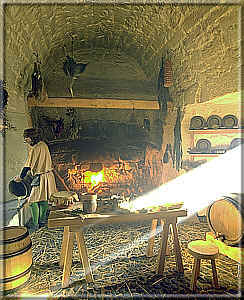Castle Rushen – Lord’s Dining Hall
Most Kings of Mann spent little or no time on the Island, leaving the efficient government and defence of their Kingdom to their officials and soldiers. One whose visit to the Island in 1507 is documented in the Manx “Traditionary Ballad” was Thomas Stanley, 2nd Earl of Derby and last King of Mann. It is his stay at Castle Rushen Isle of Man which was the basis for the recreated medieval Lord’s private Dining Hall, Great Chamber and Treasury.
Seated with the last King at his midday meal are John Farkar, Abbot of Rushen Abbey, Ralph Rushton, Governor of the Island, and the Comptroller (Controller) of the Castle.
They are shown discussing the results of an “enquest” (enquiry) in 1504 which was undertaken to establish details of the Lord’s traditional rights and the laws of the Island.
 The meals eaten on such an occasion were highly regulated, both with regard to what was eaten and how food and drink was served. Spectacular items, such as a roast peacock, with its skin and plumage sewn back on after cooking, were reserved for special occasions. By strong tradition the Crown worn by Richard III was found under a hawthorn bush and presented to Henry by Lord Thomas Stanley – grandfather of Thomas Stanley seated at the banquet table.
The meals eaten on such an occasion were highly regulated, both with regard to what was eaten and how food and drink was served. Spectacular items, such as a roast peacock, with its skin and plumage sewn back on after cooking, were reserved for special occasions. By strong tradition the Crown worn by Richard III was found under a hawthorn bush and presented to Henry by Lord Thomas Stanley – grandfather of Thomas Stanley seated at the banquet table.
The “eagle and child” badge was used by the Stanley family after their union with the Lathom family in 1385. The Legend of the Eagle and Child, depicted above the fireplace, behind the banquet table, tells of old Sir Thomas Lathom, who, being childless, finds a baby which has been carried by an eagle to its nest and adopts it as his own son.
Go to Wall Hangings | Return to Kings and Lords of Mann
